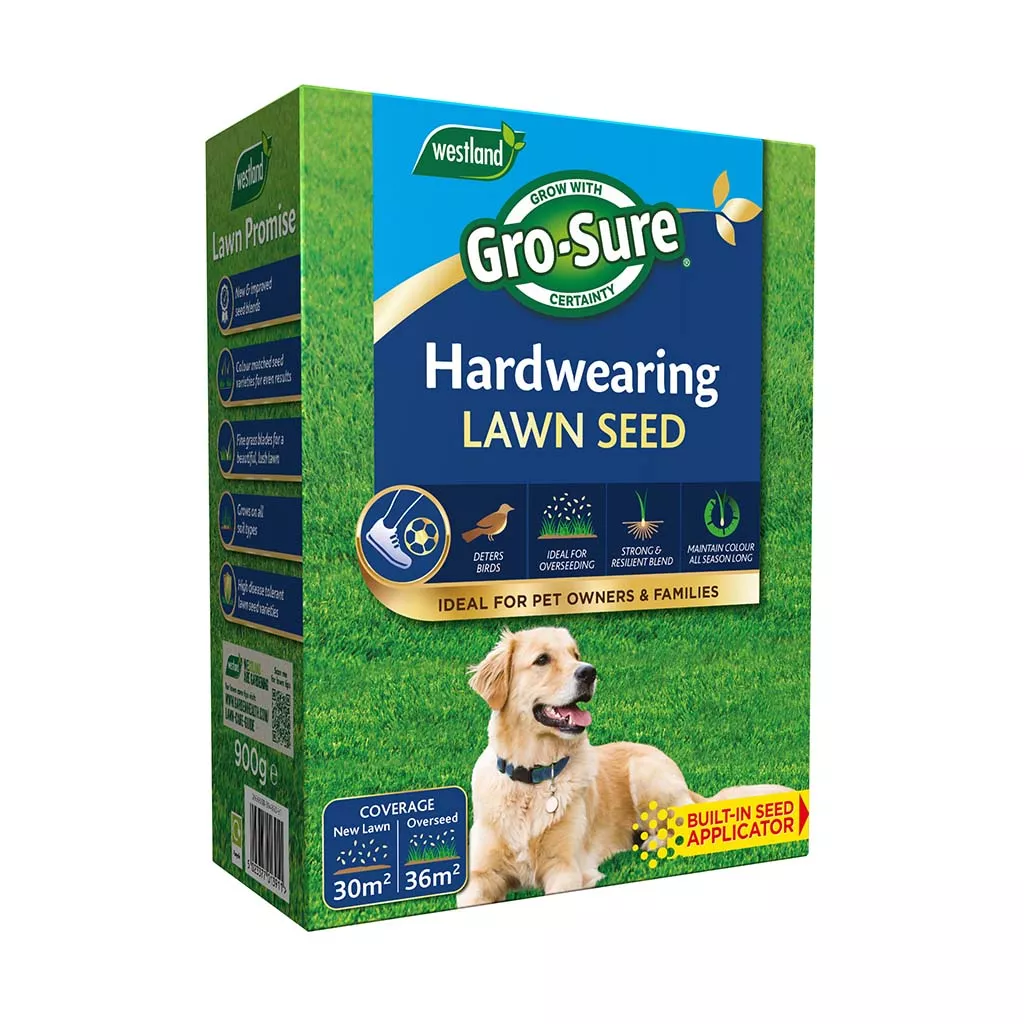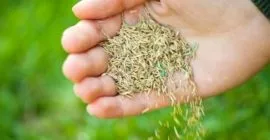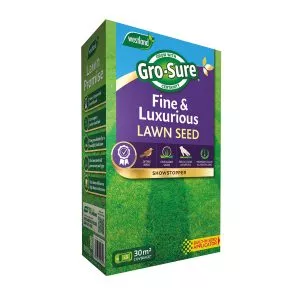Gro-Sure Hardwearing Lawn Seed creates the lush looking lawn that everyone wants! This lawn seed has a blend of strong and resilient seeds that thrive in tough conditions, thus making it perfect for lawns that need to withstand high traffic. As well as giving a lush vibrant lawn, it also makes lawns even more tolerant to pet use.
- Blend of strong and resilient seeds that thrive in tough conditions
- Deters birds
- Ideal for pet owners and families
- Withstands high traffic
- Creates a lush looking lawn
- Maintains colour all season long
- If you are using a lawn spreader, please check out our guide to Lawn Spreader Settings
Sizes available
- 30m2
- How to Use
- Overseeding
- Tips & Advice
When to Use
Lawn seed may be sown from March to October. Ideally sow during March to May or September to October.
Lawn seed grows best when the soil temperature is consistently around 10—18°C. If conditions stray out of this range, time and rate of germination can be negatively impacted.
Where to Use
Existing lawns – to over-seed
Bare soil – to establish new lawns
Patches -for repairs
How to Use
Preparation
Clear away any debris and remove and kill weeds before sowing.
New Lawn (or Patch Repair)
- Dig over the soil to a depth of 20-25cm
- Break down any lumps and firm the soil by treading it down
- Level out using a rake, creating a flat and even surface
- Spread Gro-Sure® Lawn Seeding Soil over the surface to a 3-4 cm depth and level out.
If you are using a lawn spreader, please check out our guide to Lawn Spreader Settings
Revitalising Existing Lawn
- Mow the lawn closely
- Rake or scarify the area to open up the soil surface
- Fill any shallow holes with Westland Lawn & Turf Dressing and level out.
Sowing
Tip: In dry conditions, water the soil thoroughly the day before sowing.
- Shake the box to mix up the seeds
- Lightly rake to incorporate the seed into the soil
- Walk over or roll the sown area to press the seed into the soil
Watering
- Water the area thoroughly using a fine-rose watering can or sprinkler, taking care not to wash the seeds away.
- In dry conditions, water daily to maintain soil moisture levels until seed germinates and establishes.
Aftercare
- Keep new lawns well watered especially in dry conditions.
- Do not use weed killers or strong fertilisers on new lawns and always read the product label before use.
Recommended Lawn Feeds
The overseeding of your existing lawn is an essential part of your annual lawn maintenance. All lawns are affected by the specific growing environment. This includes their level of use and general weather conditions. As a result of these conditions, its key to understand the basic principles of overseeding. Its also important to choose the right seed mix to achieve a greener and healthier lawn.
Overseeding achieves:
- To infill damaged, bare or thin patches, as well as worn areas to achieve a greater thickness
- All of our lawn seed is pantone matched. So it does not matter if you have used a previous seed product. The colour will be the same – overseeding will improve the colour of the lawn overall
- Reduce weeds and moss
When should I overseed my lawn:
The best time to do this is either in spring or autumn or both. Germination can take between 7 and 21 days so you will require the ideal conditions these seasons will bring.
Choosing the right seed:
- For shady and dry areas try our Gro-Sure Lawn Seed Shady & Dry
- For areas where your grass never seems to grow try our Gro-Sure Smart Lawn Seed
- If you need to germinate seeds quickly and in colder conditions try Gro-Sure Smart Lawn Seed Fast Start
- Our general lawn seed for all lawns is Gro-Sure Multi-Purpose Lawn Seed
- To achieve fast results use Gro-Sure Fast Acting Lawn Seed
- Areas of your lawn with lots of traffic try Gro-Sure Hardwearing Lawn Seed
- For a showstopper lawn try our Gro-Sure Fine & Luxurious Lawn Seed
How to overseed your lawn
- Mow your lawn to approx 25mm.
- Use a spring tine rake to break up and remove the layer of dead matted grass (thatch). If the depth opf the thatch is quite dense use a scaryfing rake, as this will ensure the seed make contact with the soil allowing it to germinate
- Using a garden fork or aerator to spike the lawn at 300mm intervals
- If your lawn has not been fed in the last 4 months we recommend feeding the lawn before overseeding. Your lawn can then be overseeded 3 to 4 days after applying lawn fertiliser. However, please note you will usually need to wait about 4 weeks after applying a feed, weed & moss killer. (Check the instructions on the product for this.)
- Sow the seed evenly across the lawn
- Our range of seed can be mixed with lawn seeding soil and applied to the lawn jointly. This will save a bit of time and effort working the topdressing and seed into the surface
- The seeded area must now be kept moist. Therefore, water your lawn after 2 or 3 days if no rain has fallen.
- Specific bare patches can be reseeded without treating the whole lawn. Apply the same procedure as above
- To protect specific areas from birds consider covering with netting or garden fleece. This should be removed when new shoots start to come through the soil
- Try to keep traffic on your freshly overseeded lawn to a minimum for 7 to 21 days
- Raise mowing heights to approximately 50mm for the initial 2 or 3 cuts, then reduce down to 25mm over the next 2 or 3 cuts
For any questions or advice, please contact our technical advice line on 01480 443789 (Mon-Fri 10am-4pm) or email customerservice@westlandhorticulture.com



















